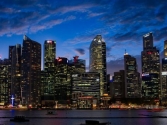
Beware of technical recession ahead, warns analyst
Standard Chartered says a technical recession could affect some Asian economies, like Singapore and Hong Kong, by the end of 3Q 2011.
After contracting 1.7% in Q2, Singapore’s economy is again expected to contract 0.9% in Q3.
Here’s more from Standard Chartered:
| Asia slows We have cut our US growth forecasts to 1.6% from 1.8% for 2011 and to 2.0% from 2.4% for 2012. This largely reflects the expected hit to confidence and corporate investment plans as a result of recent events, and this will likely spill into next year. We still expect the US to grow in the second half of this year and, as before, we anticipate further policy stimulus. But this is a weak US recovery. Below I focus on this in more detail, and on why the West faces similar challenges to those that have faced Japan since its financial bubble burst. We have also tweaked our forecasts for Asian growth, anticipating some decline in confidence and a softening in export orders. But again, the overall story remains unchanged. Some Asian economies could be in a “technical recession‟ at the end of Q3-2011. Under this widely used (but not always appropriate) definition, a recession is two successive quarters of negative quarter-on-quarter growth. Despite this, based on annual growth rates, the overall picture in Asia is, as before, one of a region moving from strong to slower but sustainable rates of growth. The economic contraction in economies such as Hong Kong and Singapore also reflects the open and volatile nature of their econcomies, where exports plus imports are high in relation to overall GDP. This slowdown also has to be put in the context of the strong recovery experienced in 2010 and early 2011. This phase of the cycle fits with our long-held view that the trend is up but that there may be setbacks along the way, reflecting both the interconnectedness of the world economy and the openness of many Asian countries. Steady job creation is likely to continue in these economies, in line with labour supply, ensuring that unemployment rates stay stable. Asian economies saw a rapid rebound last year and strong momentum early in 2011. This prompted aggressive policy tightening to curb inflation. In turn, economies have started to slow. Asian economies were thus already slowing from rapid to solid growth rates before the latest bout of financial turbulence. We have now factored in a hit to confidence overseas and at home, the net effect of which will be that some economies will experience back-to-back quarterly drops in economic activity. In Q2, for instance, both Hong Kong and Singapore – Asia‟s most open economies – saw growth rates fall from the previous quarter but total output remain above levels a year earlier. Hong Kong contracted 0.5% q/q in Q2, translating into a y/y growth rate of 5.1%. Likewise, Singapore contracted 1.7% q/q but was up 0.9% y/y. Now, following a hit to confidence and some softening of export orders, we expect Hong Kong, Malaysia, Singapore and Taiwan to contract in Q3 compared with Q2. Hence, Hong Kong and Singapore will enter technical recessions. In Q3, we expect Hong Kong to contract 0.3% q/q but to expand 3.8% y/y; Malaysia to contract 0.4% q/q and grow 3.0% y/y; Singapore to contract 0.9% q/q and be up 4.5% y/y; and Taiwan to contract 0.6% q/q and grow 3.4% y/y. The only Asian economy where we expect an outright contraction this year is Japan, which is perhaps not surprising given the earthquake. But even so, after an expected contraction of 0.4% in 2011, we think Japan can grow by 2.5% in 2012. Elsewhere in South and East Asia, we think 2011 growth rates will range from a low of 3.2% in Thailand to a high of 9.3% in China. Growth rates in the region‟s three main domestically driven economies of China, India and Indonesia were in line with our expectations in H1. Recent forward-looking indicators still support our growth forecasts of 9.3% for China, 7.7% for India and 6.5% for Indonesia this year. Next year we expect all three of these domestically driven economies to see higher growth rates, of 10.0% in China, 8.2% in India and 7.0% in Indonesia. This highlights many issues. The first is the very different economic picture across much of Asia compared with the West, with a slowdown to sustainable growth rates in Asia contrasting with a very weak West. The second is the open nature of many Asian economies, which makes them prone to sharp swings in activity. The third, following from this, is that Asia is not decoupled from events in the West. Indeed, as we saw at the height of the global financial crisis, events in the West can hit Asia hard. That being said, Asia is better diversified and protected now, with more room for policy manoeuvre if needed – either by putting monetary tightening on hold, as has already happened in China, or relaxing fiscal policy if necessary.
|























 Advertise
Advertise










